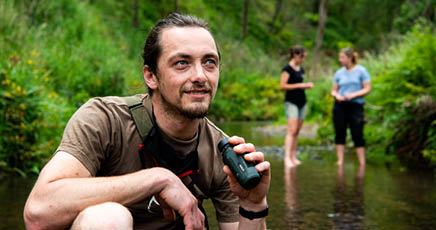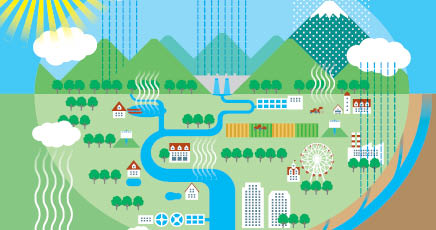LEARNING ACTIVITY
STORY
Amir and his friends have been making an effort to go to the beach in the morning on the 4th Sunday of the month. They help the local Coastcare group pick up rubbish, remove weeds and plant native seedlings along the sand dunes. While Amir loves being able to protect our marine environment from pollution, his favourite thing about the community volunteer day is listening to Mick tell stories of how their local environment has changed over time.
Amir could not believe that when Mick was young, the area where Amir lives was farmland. What was once a pig farm then, is now the block of units where Amir and his family and a lot of other people live!

Water is an important resource, and is required by all living species to survive. Water is also important for many industries and businesses. This activity investigates the different land uses over time across your local catchment.
This learning activity is the second part of a sequence of 5 individual learning activities focused on catchment management. The order of these learning activities are: the story of a river, water sustainability, what’s in a drop?, the drain is just for rain and where the river meets the sea.
For children to:
- understand the natural and urban water cycle
- learn about the different land uses for water in your local area
- understand the competing pressures for water security in a catchment
- appreciate that what happens on land can impact our rivers and oceans
- recognise strategies to help water sustainability locally.
This activity can be undertaken at any time of year.
Introduction
This water sustainability learning activity investigates the different uses for water across a catchment. Within a community, stakeholders can have different opinions on how water should be shared. Explore these competing demands for water in a typical catchment, and discover ways of being more sustainable.
*Time allocation includes 15 minutes of pre reading the case study resources.
Checklist
Instructions
STEP 1:
What is water sustainability?
Begin a discussion as a class on water sustainability and changes in water use over the last 250 years.
Reflect on what you discovered from the story of a river activity. What do you already understand about water sustainability?
Use local information or the National Geographic article from the reference list to help frame the conversation.
STEP 2:
Land use in your area
As a class, discuss the land uses in your local area. You may want to create a map.
Use the list of land uses from the story of a river activity. Using Google maps, make a colour coded map of the local land uses in your catchment.
You may wish to include the following land uses:
- Residential
- Industrial
- Rural
- Agricultural
- Recreational zones
Refer to the educator notes for more details.
Mark the areas where you think water is wasted.
Using the activity sheet, mark the urban water cycle elements that are present in your catchment.
STEP 3:
Case study: History of Sydney Olympic Park
Use Sydney Olympic Park or a local example to look at changing land uses over time and impact they have had on the local area.
Watch the video Sydney Olympic Park: A Place Rich in History.
Find out about the Indigenous history of Sydney Olympic Park.
Discover ways the Environment of the Sydney Olympic Park site has been restored.
Learn about Sydney Olympic Park’s integrated approach to water conservation and catchment management.
STEP 4:
Change of land use in your area
Together, discuss the changing land uses over time in your area. Do you know of any land uses in your area where the water has polluted the catchment?
In the activity sheet, make a list of strategies (your ideas) that can help ensure water sustainability in your local area. Ideas include water recycling, water efficiencies, wastewater and rainwater tanks.
Extension Activity
Contact your local Aboriginal or Torres Strait Islander group to find out their words or names for local water and rivers. Invite them to your location to share the cultural significance of your local waterways and how resources are used.
Research changes in land use in your local area over time. How has access to clean freshwater changed in your local area over the last 500 years? Create a timeline of these changes.
Curriculum and Framework Links
SCIENCE
Year 7: ACSSU111, ACSSU112, ACSSU116, ACSHE120, ACSHE121, ACSIS124, ACSIS125, ACSIS130, ACSIS131, ACSIS132
Year 8: ACSHE135, ACSIS140, ACSIS145, ACSIS146, ACSIS234
Year 9: ACSSU175, ACSSU176, ACSIS164, ACSIS165, ACSIS170, ACSIS172, ACSIS174
Year 10: ACSSU189, ACSHE191, ACSHE194, ACSIS199, ACSIS204, ACSIS206, ACSIS208
Biology
Unit 1: Biodiversity and the interconnectedness of life
Earth and Environment Science
Unit 1: Introduction to Earth systems
Unit 3: Living on Earth – extracting, using and managing Earth resources
Unit 4: The changing Earth – the cause and impact of Earth hazards
HUMANITIES AND SOCIAL SCIENCES
Year 7: ACHASSI152, ACHASSI155, ACHASSI154, ACHASSI155, ACHASSI156, ACHASSI158, ACHASSI159, ACHASSI160, ACHASSI161, ACHASSI162, ACHASSK183, ACHASSK185, ACHASSK187
GEOGRAPHY
Year 7: ACHGK037, ACHGK038, ACHGK040, ACHGK042, ACHGS047, ACHGS048, ACHGS049, ACHGS050, ACHGS051, ACHGS052, ACHGS054
Year 8: ACHGK048, ACHGK050, ACHGK051, ACHGK053,ACHGS055, ACHGS056, ACHGS060, ACHGS062
Year 9: ACHGK065, ACHGS068, ACHGS070
Year 10: ACHGK070, ACHGK073, ACHGK074, ACHGK075, ACHGS079
Unit 1: Natural and ecological hazards
Unit 2: Sustainable places
Unit 3: Land cover transformations
HEALTH AND PHYSICAL EDUCATION
Year 7 & 8: ACPPS073
ETHICAL UNDERSTANDING
Exploring values, rights and responsibilities
PERSONAL AND SOCIAL CAPABILITY
Social awareness
CURRICULUM CONNECTIONS
Outdoor Learning
CROSS CURRICULUM PRIORITY
Sustainability
Reference List
ONLINE RESOURCES
Read National Geographic’s article on the Urban Water Cycle: Sustaining Our Modern Cities.
Find out about the Indigenous History of Sydney Olympic Park.
Discover ways the Environment of the Sydney Olympic Park sites have been restored.
Learn about Sydney Olympic Parks integrated approach to water conservation and catchment management.
PRINTABLE RESOURCES
Sydney Water Urban Water Cycle Diagram
Label the Urban Water Cycle from Sydney Water
History of Sydney Olympic Park (available from Sydney Olympic Park’s online resource centre)
Sydney Olympic Park: Urban water reuse and integrated water management
WATCH
Watch this video from Sydney Olympic Park on the changing land uses of the site over the last 250 years (9 minutes).
We value your feedback
When you have finished this learning activity, please tell us what you think with our survey.
Your feedback will help Landcare Australia improve the activities in the Junior Landcare Learning Centre.
Why not try one of our other Junior Landcare learning activities?
Love Letters to the Land
Biodiversity|First Nations Perspectives|Food Production|Waste Management
Creating a worm farm
Waste Management
Caring for our coasts: beach clean-up
Waste Management
Waterways: clean-up
Waste Management


